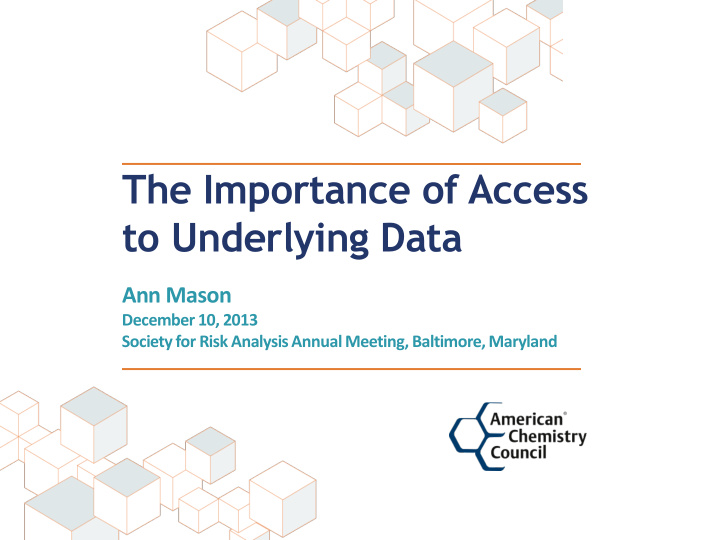



The Importance of Access to Underlying Data Ann Mason December 10, 2013 Society for Risk Analysis Annual Meeting, Baltimore, Maryland
So Why is Access to Data Important? Validity and quality of findings Statistics and correlations Comparison to other studies Currently: Underlying data might be available as supplemental information to journal; but not uniformly available EPA requesting raw data from some authors but not all for IRIS assessments Databases on exposure are limited
The Need for Access to Underlying Data Scientific & research studies are used as foundation for policy & regulatory decisions Governmental Characterizations and Assessments: EPA’s Integrated Risk Information System (IRIS) is a database of cancer and non-cancer toxicity criteria for use within EPA The National Toxicology Program (NTP) Report on Carcinogens reports agents and substances “known” or “reasonably anticipated” to cause cancer in humans The Agency for Toxic Substances and Disease Registry (ATSDR) has a database of hazard values for non cancer effects States frequently develop their own hazard values Regulatory standards Product safety Workplace protections
Why Need Data? Example 1: Clarify Dose : Exposure Relationship Blood Exposure Chemistry Federally- Funded Individual Observed Personal Effects Epidemiology Monitors Study as basis FOIA to EPA Used Paper as for MOA access Evidence of Critical exposure Pathway for Effects in Hypothesis data IRIS Assessment Effects from disease or chemical exposure?
Why Need Data? Example 2: Replicate Data Analysis Effects Exposure Federally- Reported Cancer Groups: Peak Funded Effects Exposure? Human EPA Used Papers as Cohort Study FOIA to access data Evidence of Adverse as basis for Effects in IRIS Assessment IRIS risk Data grouped to prevent subject identity values Technology transfer agreement
Why Need Data? Example 3: Develop PBPK Model Bioassay MOA Study Industry MOA study to Identify Gov-funded bioassay Funded Key Events reported cancer effects Mode of Publications included • Agency shared slides Data Supplements Action Study for pathology evaluation Raw data submitted to regulations.gov EPA & States Assumed Linearity Data and model in Assessments shared with EPA Will agencies use data?
Summary Governmental assessments establish toxicity criteria to derive “safe” levels -- input into regulatory standards; used by other agencies’ Access to federally-funded raw data used in governmental assessments are difficult (nearly impossible) to obtain FOIA access: data grouping prevents/limits reanalysis Access to raw data needed to answer/clarify key questions: Dose response Causality Uncertainties and the need to apply assumptions
The Need for Access to Underlying Data Shelby Amendment (1998) (Public Law 105-277) Directed OMB to amend Circular A- 110 “to ensure that all data produced under an award will be made available to the public through the procedures established under the Freedom of Information Act” Revised OMB Circular A-110 (1999) Limited to: Published research findings (journal) Used to support agency action that has “force and effect of law” (rule, regulation) Excludes: Data never published or cited Data used in formulating risk assessments or guidelines
Recommend
More recommend